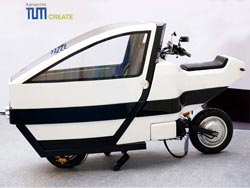TUM CREATE unveils revolutionary two-wheeler at EV Taiwan 2013: Compact multipurpose scooter for crowded megacities

Multipurpose electric scooter VOI<br>
VOI gets its name from the Vietnamese word for elephant – a symbol of a safe and intelligent mean of transport. It is a two-wheel concept vehicle jointly developed by students from Technische Universität Muenchen (TUM) and Singapore’s Nanyang Technological University (NTU), and was built in Singapore.
The design brief for the VOI was to develop a two-wheel transporter that is as agile and affordable as a scooter and, at the same time, as safe and comfortable as a car. With its compact size and maneuverability, the two-wheel electric scooter is designed as a transporter for densely populated megacities and offers a comprehensive solution to metropolises where congested traffic is a major problem.
Positioning the rider behind allows for a compact design and the use of an enclosed passenger cabin that shields occupants from the elements. The enclosure also offers added rigidity and stiffness to the vehicle chassis, which provides additional passenger protection.
With the VOI, business people are able to commute quickly, comfortably and safely through the gridlocks to rush from one meeting to another. It can also address the ‘First/Last Mile Problem’, where it complements an existing metro railway and public transport system, to offer commuters intermediate transportation between the stations to their destinations.
Furthermore, the VOI is not just limited to transporting passengers. Its modular front pod can be swapped for a cargo box or even a mobile kitchen – making it a multipurpose vehicle. It is not only a more efficient mode of transport; it also reduces pollution within a metropolis with zero tailpipe emissions. Thanks to its lightweight design, the VOI is capable of reaching a nominal range of 80 km and has a maximum speed of 45 km/h.
Project VOI is an urban mobility concept developed by final-year students from both universities and is a Work-in-Progress prototype to demonstrate the possibilities of future mobility. This project is just one of many research and development works undertaken by over 100 scientists, researchers and engineers from more than 20 countries at TUM CREATE. The cutting-edge research covers topics ranging from molecules to megacities including areas such as: electrochemistry, electric vehicle battery packs, embedded systems, air conditioning, simulation and modeling, and infrastructure.
TUM CREATE will mark another significant milestone and set history later this year when it will present the electric taxi prototype, codenamed EVA, at the Tokyo Motorshow – Asia’s largest and most important automotive trade show. EVA is a platform to showcase the research, development and innovations of TUM CREATE.
Media Contact
More Information:
http://www.tum-create.edu.sgAll latest news from the category: Trade Fair News
Newest articles

Parallel Paths: Understanding Malaria Resistance in Chimpanzees and Humans
The closest relatives of humans adapt genetically to habitats and infections Survival of the Fittest: Genetic Adaptations Uncovered in Chimpanzees Görlitz, 10.01.2025. Chimpanzees have genetic adaptations that help them survive…

You are What You Eat—Stanford Study Links Fiber to Anti-Cancer Gene Modulation
The Fiber Gap: A Growing Concern in American Diets Fiber is well known to be an important part of a healthy diet, yet less than 10% of Americans eat the minimum recommended…

Trust Your Gut—RNA-Protein Discovery for Better Immunity
HIRI researchers uncover control mechanisms of polysaccharide utilization in Bacteroides thetaiotaomicron. Researchers at the Helmholtz Institute for RNA-based Infection Research (HIRI) and the Julius-Maximilians-Universität (JMU) in Würzburg have identified a…



